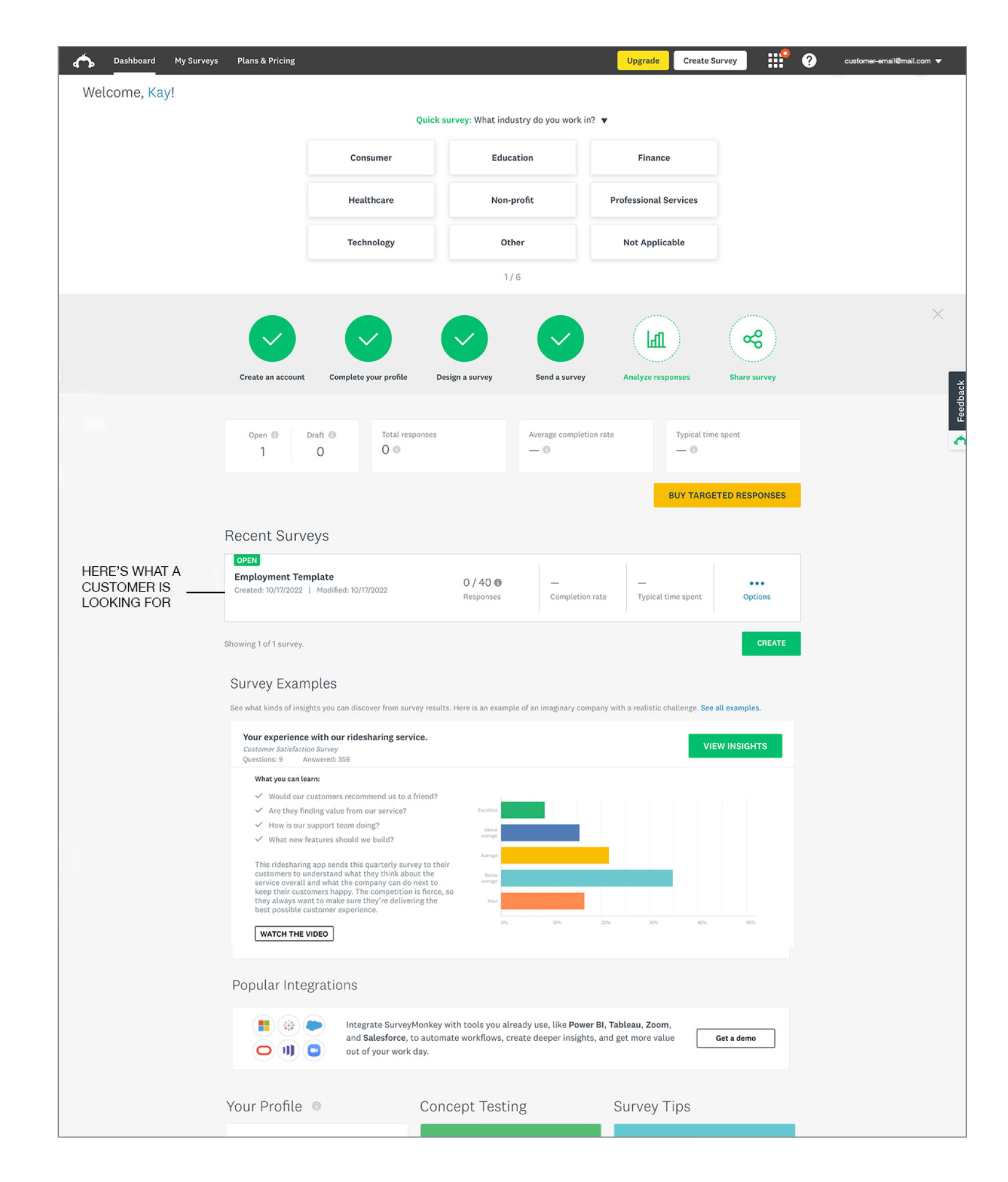From Vision to Reality
Designing A Navigable Path To Enterprise Success

Snapshot
SurveyMonkey sought to capture more enterprise market share by improving its survey experience for large organizations. Through research and collaboration, my team created a future vision ("visiontype") to simplify the survey journey and enhance collaboration tools. The first release—a revamped homepage—increased survey launches by 12%. This success was an initial step in a broader transformation to establish SurveyMonkey as a go-to platform for enterprise research needs.
Outcomes
I led the design team to craft a customer-centric vision for the enterprise survey experience, aligning with business objectives and inspiring new thinking across teams. The revamped homepage:
-
Addressed long-standing customer complaints about clutter and navigation.
-
Drove a 12% increase in survey launches, improving overall user engagement.
-
Set the foundation for further iterative improvements that better served enterprise customers.
-
Strengthened internal alignment across design, product, and engineering on an enterprise-focused direction.
-
Provided a scalable framework for future improvements based on customer and data insights.
Context
SurveyMonkey's enterprise ambitions required modernizing its product for large organizations. Historically known for ease of use, the company had not released significant core experience updates since 2009. Leadership tasked me with creating a visiontype to:
-
Address enterprise needs and improve collaboration tools.
-
Align the core survey experience with business objectives for up-market growth.
-
Execute within a tight two-month timeline during Q4.
-
Lay the groundwork for an iterative, research-backed product development approach.
Customer feedback indicated dissatisfaction with the cluttered homepage, where promotional content overshadowed their active projects. The visiontype aimed to resolve this by prioritizing project management and team collaboration while maintaining the simplicity that had been a long-time brand differentiator.

Only one component on the account home page was customer created: their survey list, found in the middle of the page. The rest of the content was for cross-selling or provocations to move their projects forward.
Assumptions
To succeed, we needed to:
-
Align with business objectives for moving up-market.
-
Understand the workflows of multi-seat accounts conducting collaborative research.
-
Create a narrative that demonstrates competitive advantages.
-
Inspire executives and cross-functional teams to invest in our vision.
-
Ensure that any design updates did not compromise the existing customer base’s trust in SurveyMonkey’s usability and efficiency.
-
Maintain balance between forward-looking vision and feasible implementation within existing technical constraints.
Research
Partnering with the head of research, I ensured the design team was immersed in customer insights. Through 65 interviews with 40 companies, we identified:
-
Four personas engaged in research within enterprise customers.
-
A refined customer journey map that highlighted collaboration pain points at each stage.
-
A lack of enterprise-focused workflows and tools that made it difficult for research teams to manage large-scale projects.
-
A growing need for customizable dashboards and streamlined reporting options for executives.
Designers participated in research sessions, which enriched their understanding and jumpstarted solution ideation. A key insight emerged: No competitor effectively solved for teamwork and collaboration in survey research. This finding became the core driver of our design vision and fueled further innovation discussions across the company.
Personas

Journey

Design: Crafting the Visiontype
I outlined a narrative-driven approach to guide the visiontype, focusing on critical collaboration moments. Five designers tackled different stages of the survey journey, ensuring:
-
Defining shared goals was streamlined with AI-powered survey question suggestions.
-
Survey creation and review allowed seamless stakeholder feedback.
-
Analysis and insights sharing were optimized for executive reporting via a visual dashboard.
-
Permissions and team roles were more clearly defined to avoid confusion over survey access and editing rights.
The visiontype storytelling approach resonated with leadership, earning executive buy-in and approval to move forward. The alignment gained through this effort helped prioritize key initiatives across engineering and product, ensuring design-led innovation remained at the forefront.
Account home page with current projects

Team members collaborating on survey goals and design

Survey preview enabling collaborative feedback

Preview of sample results prior to survey launch

Building visual insights dashboard using library

An easy-to-digest dashboard, shareable to entire company

Iteration: Refining to Release
We prioritized redesigning the logged-in homepage as a low-effort, high-impact first step. This decision was informed by customer feedback indicating that navigation issues were a major pain point, and data showed that users frequently struggled to locate their ongoing projects efficiently.
Key design improvements:
-
Clearer Navigation: Quick access to individual and team projects, with improved hierarchy and organization.
-
Project Space: A card-based system displaying essential details such as survey status, collaborators, and fielding progress, with clearer visual differentiation between active, draft, and completed surveys.
-
Communication Zone: A space for admin messages, SurveyMonkey insights, and cross-sell opportunities, designed to be informative without being intrusive.
-
Improved Mobile Accessibility: Ensuring the new designs functioned well across different screen sizes, a key factor for enterprise teams working remotely or in hybrid setups.
Through two rounds of usability testing, we refined the design for clarity, simplifying overly ornate visuals for better scanning and ease of understanding. This ensured the final iteration struck the right balance between visual appeal and functional simplicity. Key learnings from the usability studies informed additional refinements, such as improving the contrast of key UI elements and simplifying navigation labels.
First iteration of the home page, with the creative focus of bringing life to the page

Feedback is essential to any design: we conducted two rounds of research to assess understandability and usability on a version of the above design. While visually lively, our prototype was too ornate and complicated to parse easily. We needed to streamline and refine our design for better scanning and ease of understanding. Below, you can see two iterations of a cleaner design, refined through rounds of research and experimentation.
Final Takeaways
This project exemplified how strategic vision, customer insights, and cross-functional collaboration can deliver meaningful business impact. By fostering a culture of innovation and customer-centric design, I led the team to:
-
Craft a compelling vision aligned with business growth.
-
Deliver tangible customer and business benefits.
-
Inspire teams to build on this foundation for continued enterprise success.
-
Establish a research-backed iterative design process that continued beyond the initial homepage redesign.
This work was not just about improving a single touchpoint—it laid the groundwork for a more structured, data-driven approach to enterprise product design at SurveyMonkey. The project reinforced the role of design in shaping business strategy and provided a clear model for how research-driven design can drive meaningful customer and business outcomes.


